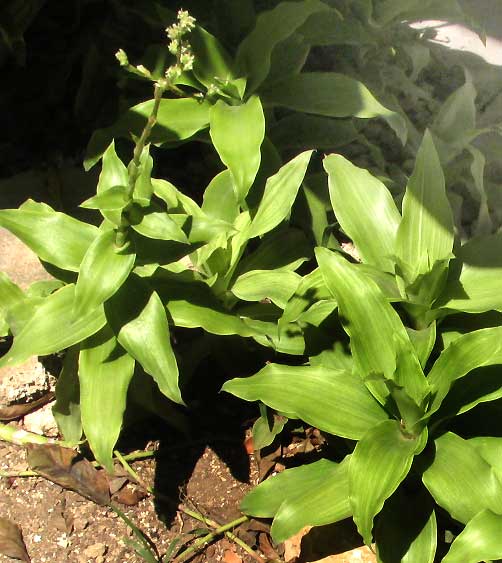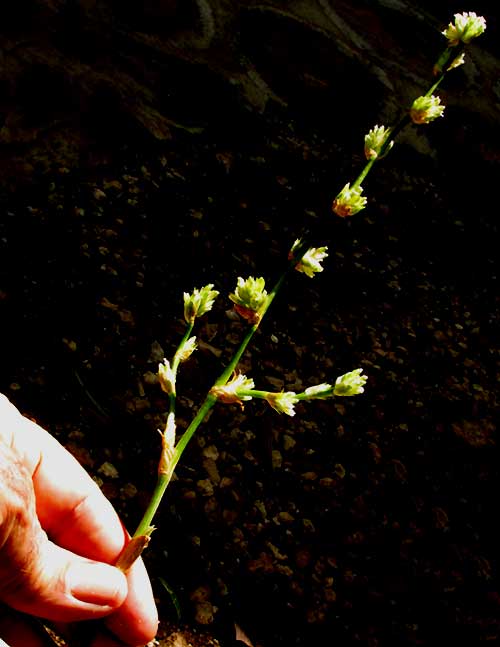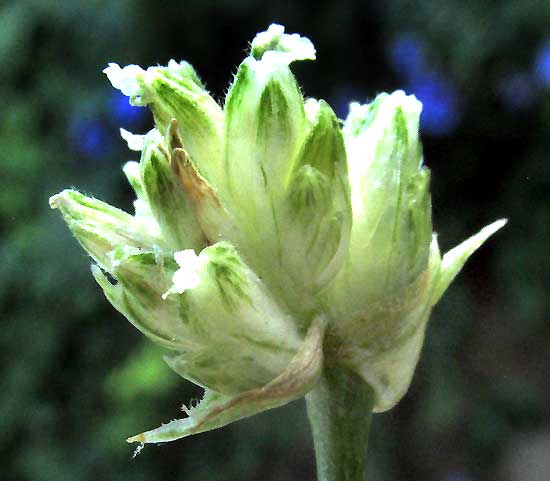Excerpts from Jim Conrad's
Naturalist Newsletter
from the April 20, 2019 Newsletter issued from Rancho Regensis north of Valladolid, Yucatán, MÉXICO;
elevation ~40m (~130 ft), N~20.876°, W~88.170°
BASKET PLANT
Last month when I passed through Mérida on my way to Guatemala, on March 26th, I got to look around the backyard garden of my friends Eric and Mary, and see something I've been looking for. It's shown below:

Up north often I've seen this plant filling indoor flowerpots. It's nothing very spectacular, just something that's easy-to-grow producing succulent greenness that looks cheerful in a wintry room when placed on a sunny windowsill. Down here it's commonly seen in walled-in backyard gardens like Eric and Mary's, where with time it can form a lush, solid ground cover, even in deeply shaded gardens. Thing is, I've never known exactly what the plant was, because I'd never seen a plant flowering. A plant in the picture is flowering.
I've always assumed that the plant was a member of the medium-size (±650 species in over 40 genera), mostly tropical and subtropical Spiderwort Family, the Commelinaceae, to which Day-flowers and Wandering-Jews also belong. That's because of the plant's semi-succulent, slimy-juiced (mucilaginous) , rosette-forming, strap-shaped leaves with parallel veins. I was surprised, however, by this plant's cluster of small, white flowers, which wasn't right for the usual genera. A closer look at the flowering cluster, or inflorescence, is shown below:

A close-up of one of the inflorescence's several flower groupings appears below:

This shows several individual flowers forming a head closely subtended by scale-like bracts, which is typical of the family, though in other species often the bracts are much larger, often partly enclosing the clusters of flowers. None of the flowers in our picture bear fresh corollas. I assume that the white, irregular-shaped items atop each calyx is a wilted corolla. Corollas in the Spiderwort Family are famous for their quick withering, especially among the dayflowers with their blossoms lasting one day. In Eric's scorchingly hot garden, I'd not be surprised if they last only an hour or two in early morning.
The inflorescence's structure led me to the genus Callisia, at which point on the Internet it was easy enough to find pictures of our plant (keywords Commelinaceae topical ornamental) because of its wide use as an indoor and garden ornamental.
It's CALLISIA FRAGRANS, in English known by such names as Basket Plant, Chain Plant and Inch Plant. Originally it's from upland central Mexico, but not only is it much planted worldwide, but in numerous tropical and subtropical countries it's been naturalized, gone wild. The fragrans in the name refers to the flowers' sweet fragrance, of which our wilted flowers offered no hint.
Traditionally Basket Plant has been used medicinally in many ways. In Eastern Europe its leaves are used for skin diseases, burns and joint problems. In the lab it shows antiviral and antimicrobial action.